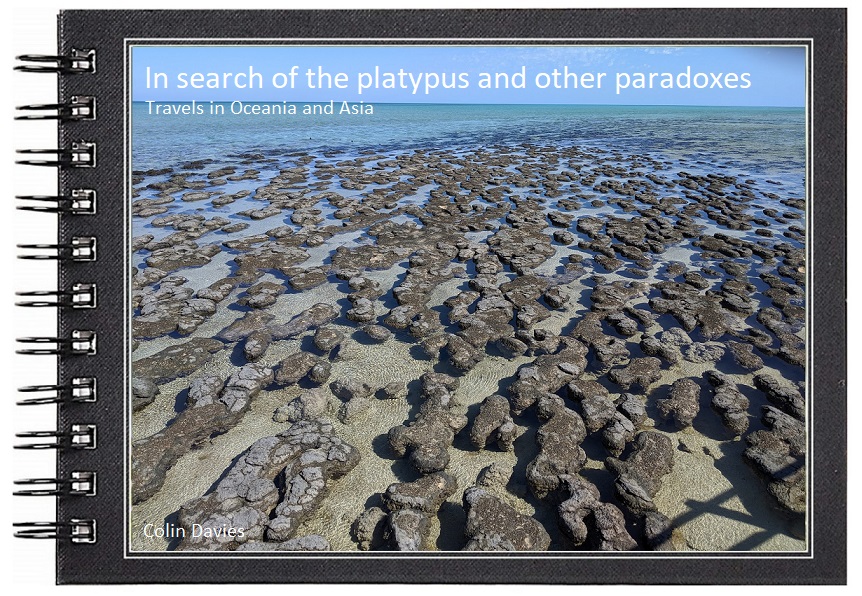Here's a full list of the 320 bird species and 30 mammal species I've seen so far in Australia, grouped by state and location. The numbers in brackets are the maximum number of individuals I have seen at each location.
State
|
Location
|
Species seen with maximum numbers in brackets
|
NSW
|
Blue Mountains
|
Australian Magpie (10), Australian Raven (1), Australian Wood
Duck (2), Bell Miner (20), Black-faced Cuckoo-shrike (1), Brown Thornbill
(2), Common Myna (30), Crescent Honeyeater (1), Crimson Rosella (20), Eastern
Spinebill (1), Fan-tailed Cuckoo (1), Galah (10), Golden Whistler (5), Grey
Fantail (1), Lewin's Honeyeater (1), Magpie-lark (1), Masked Lapwing (1),
Pacific Black Duck (2), Peregrine (1), Pied Currawong (10), Red Wattlebird
(2), Red-whiskered Bulbul (10), Satin Bowerbird (2), Sulphur-crested Cockatoo
(50), Welcome Swallow (20), White-browed Scrubwren (5), White-throated
Treecreeper (2)
|
NSW
|
Sydney
|
Australasian Gannet (2), Australasian Grebe (2), Australian
Darter (2), Australian Magpie (6), Australian Pelican (8), Australian Raven
(5), Australian White Ibis (50), Australian Wood Duck (30), Black Swan (6),
Black-browed Albatross (1), Caspian Tern (1), Channel-billed Cuckoo (1),
Chestnut Teal (2), Common Myna (50), Coot (50), Cormorant (2), Crested Pigeon
(5), Crested Tern (2), Dusky Moorhen (5), Fairy Martin (5), Fluttering
Shearwater (500), Grey Butcherbird (2), Hardhead (50), House Sparrow (1),
Intermediate Egret (3), Kelp Gull (2), Laughing Kookaburra (2), Little Black
Cormorant (2), Little Pied Cormorant (20), Little Raven (1), Magpie-lark (4),
Masked Lapwing (3), Nankeen Kestrel (1), New Holland Honeyeater (5), Noisy
Miner (50), Pacific Black Duck (4), Peregrine (1), Pied Cormorant (4), Pied
Currawong (5), Purple Gallinule (50), Rainbow Lorikeet (30), Red Wattlebird
(3), Short-tailed Shearwater (200), Silver Gull (50), Spotted Dove (5),
Starling (50), Sulphur-crested Cockatoo (8), Superb Fairy-wren (5),
Wedge-tailed Shearwater (500), Welcome Swallow (50), White-browed Scrubwren
(3), White-faced Heron (1), Willie Wagtail (2), Yellow-tailed Black-Cockatoo
(5)
Mammals: Humpback whale, Indo-Pacific Bottlenose dolphin, New Zealand fur seal, grey-headed flying-fox Key locations: Sydney botanic gardens, Centennial Park, Watson Bay, whale watching trip. |
QLD
|
Atherton Tablelands
|
Australasian Figbird (30), Australian Brush-turkey (3),
Australian Pelican (5), Black Kite (50), Black-faced Monarch (2), Brown
Treecreeper (1), Coot (20), Dusky Honeyeater (2), Eastern Cattle Egret (50),
Golden Whistler (5), Great Crested Grebe (50), Large-billed Gerygone (10),
Laughing Kookaburra (3), Little Eagle (1), Magpie-lark (5), Mistletoebird
(1), Olive-backed Sunbird (2), Pacific Black Duck (6), Pied Currawong (2), Purple
Gallinule (2), Rainbow Lorikeet (50), Silvereye (1), Spangled Drongo (3),
Spotted Harrier (1), Sulphur-crested Cockatoo (10), Varied Triller (1),
Whistling Kite (1) Mammals: Duck-billed platypus, Eastern grey kangaroo Key locations: Yungaburra |







